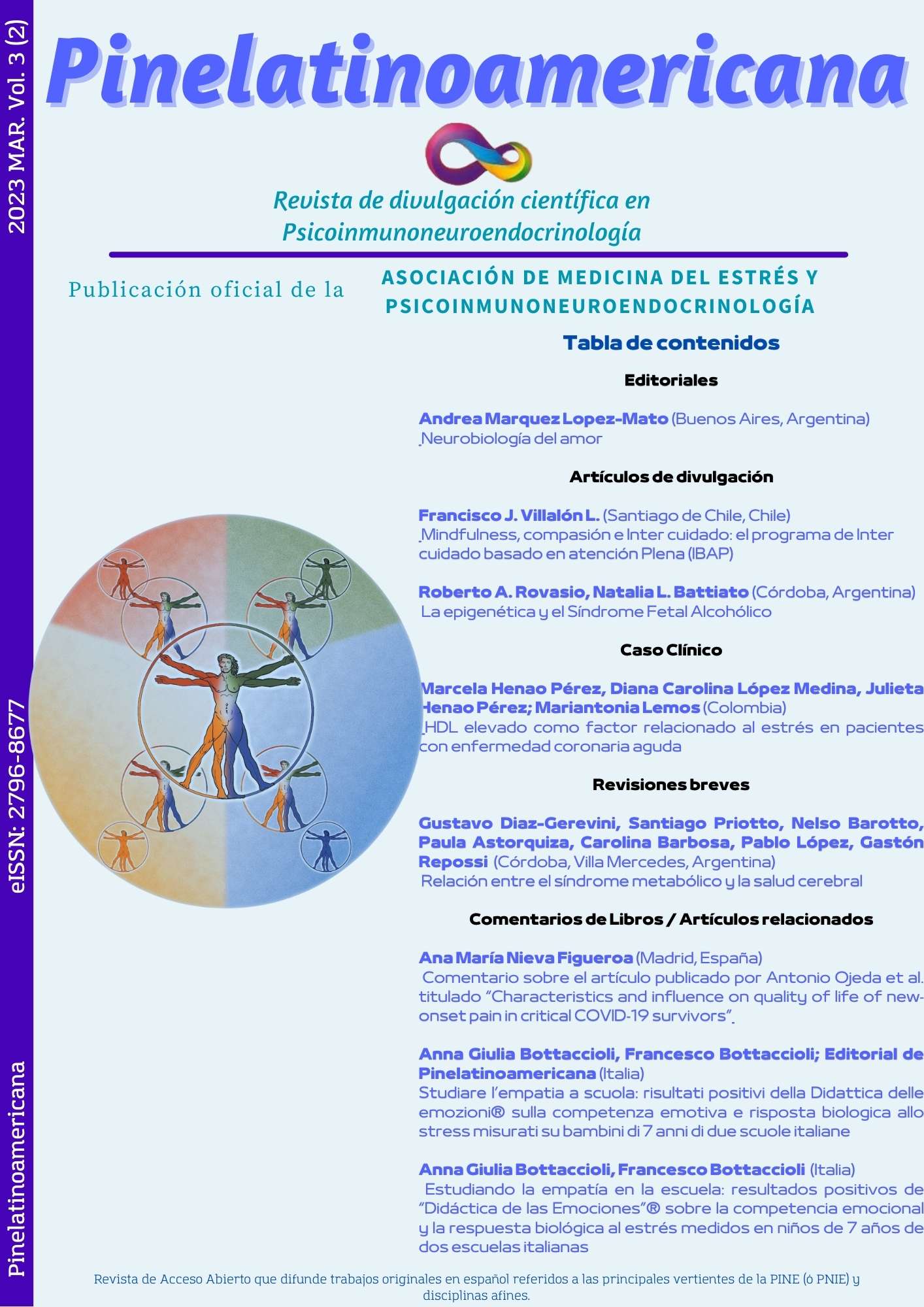Abstract
When did love start? At what historical moment of humanity? When did animal sexual intercourse become into a deepest love and more enduring? Is love just an evolutionary progression to stay longer with the most suitable partner for reproduction? These questions and others are the ones that self interpellate the author in this article, answering them from the perspective of the neurobiology of love between human beings, its stages and characteristics. Several reflections are proposed and discussed in a particular way from psychological, behavioral, neuroanatomical and neurochemical approaches according to the evidence of comparative ethology, evolutionary development and historical antecedents.
References
Badinter, E. (1993). XY la identidad masculina. Grupo Editorial Norma. Bogotá. 1993
Buss, D. M., y Schmitt, D. P. (1993). Sexual strategies theory: an evolutionary perspective on human mating. Psychological review, 100(2), 204–232. https://doi.org/10.1037/0033-295x.100.2.204
Caldiz, L. S. (1990). Viviendo nuestra sexualidad. Editorial Estaciones. Buenos Aires.
Cavagna, N. (2004). Diferencias de género en sexualidad. En: A. Lopez Mato, A. Vieitez y D. Bordalejo (comp.), Afrodita, Apolo y Esculapio: diferencias de género en salud y enfermedad. Ed Polemos. Buenos Aires.
Clarke, E., Bradshaw, K., Drissell, K., Kadam, P., Rutter, N. y Vaglio, S. (2022). Primate Sex and Its Role in Pleasure, Dominance and Communication. Animals: an open access journal from MDPI, 12(23), 3301. https://doi.org/10.3390/ani12233301
Crosby, C. L., Durkee, P. K., Sedlacek, A. G. B. y Buss, D. M. (2021). Mate Availability and Sexual Disgust. Adaptive human behavior and physiology, 7(3), 261–280. https://doi.org/10.1007/s40750-021-00168-2
Eckstein, M., Bamert, V., Stephens, S., Wallen, K., Young, L. J., Ehlert, U. y Ditzen, B. (2019). Oxytocin increases eye-gaze towards novel social and non-social stimuli. Social neuroscience, 14(5), 594–607. https://doi.org/10.1080/17470919.2018.1542341
Fisher, H. (1999) El primer sexo. Taurus. Buenos Aires.
Flores Colombino, A. (2003) El lenguaje sexual. A&M Ediciones. Uruguay.
Foucault, M. (2008). The History of Sexuality: The Will to Knowledge: (Vol. 1). Penguin Books.
Gindin, L. (1987). La nueva sexualidad del varón. Ed. Paidós. Buenos Aires.
Gindin, L. (1988). La nueva sexualidad de la mujer. Ed. Paidós. Buenos Aires.
Guevara Guzmán, R. (2004) ¿Cuál es el papel de las feromonas en la conducta sexual humana? Rev Fac Med UNAM, 47 (1), 16-20. https://www.medigraphic.com/pdfs/facmed/un-2004/un041e.pdf
International Society of Psychoneuroendocrinology. (1998). Psychoneuroendocrinology 23 (8), 749- 1014. https://www.sciencedirect.com/journal/psychoneuroendocrinology/vol/23/issue/8
Kaplan, H. S. (1982). Trastornos del deseo sexual. Ed Grijalbo. Barcelona.
Kaplan, H. S. (2014). La nueva terapia sexual: tratamiento activo de las disfunciones sexuales (3 ed.) Alianza
Martínez de León, H. (2010). Historia de la obscenidad. Olmo Ediciones. Buenos Aires.
Masters, W., Johnson V. y Kolodny, R. (1996). Eros. Los mundos de la sexualidad. Ed Grijalbo. Barcelona,
Quintana, G. R., Mac Cionnaith, C. E., & Pfaus, J. G. (2022). Behavioral, Neural, and Molecular Mechanisms of Conditioned Mate Preference: The Role of Opioids and First Experiences of Sexual Reward. International journal of molecular sciences, 23(16), 8928. https://doi.org/10.3390/ijms23168928
Sapetti, A. (2001). El sexo y el varón de hoy. Emecé Editores. Buenos Aires.
Sapetti, A. (2014). Sexo. Un camino hacia el placer compartido. Editorial Lea,
Schäfer, I. y Fisher, H. L. (2011). Childhood trauma and psychosis - what is the evidence?. Dialogues in clinical neuroscience, 13(3), 360–365. https://doi.org/10.31887/DCNS.2011.13.2/ischaefer
Vieitez A, Bordalejo D. (2004). Neurobiología del amor. En: A. Lopez Mato, A. Vieitez y D. Bordalejo (comp.), Afrodita, Apolo y Esculapio: diferencias de género en salud y enfermedad. Ed Polemos. Buenos Aires.
Villalón, L. F. J. (2023). Mindfulness, compasión e intercuidado: su marco conceptual. Pinelatinoamericana, 3(1), 42–53. https://revistas.unc.edu.ar/index.php/pinelatam/article/view/40756
Weil, R. (1993). Sometimes a Scepter is Only a Scepter: Pornography and Politics in Restoration England. En L. Hunt (Ed.), The Invention of Pornography: Obscenity and the Origins of Modernity, 1500–1800 (pp. 125–154). Zone Books. https://doi.org/10.2307/j.ctv14gpj76.7

This work is licensed under a Creative Commons Attribution-NonCommercial 4.0 International License.
Copyright (c) 2023 Pinelatinoamericana

